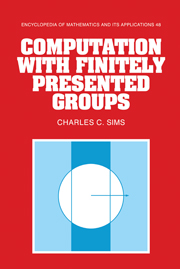Book contents
- Frontmatter
- Contents
- Preface
- Introduction
- 1 Basic concepts
- 2 Rewriting systems
- 3 Automata and rational languages
- 4 Subgroups of free products of cyclic groups
- 5 Coset enumeration
- 6 The Reidemeister-Schreier procedure
- 7 Generalized automata
- 8 Abelian groups
- 9 Polycyclic groups
- 10 Module bases
- 11 Quotient groups
- Appendix Implementation issues
- Bibliography
- Index
Introduction
Published online by Cambridge University Press: 06 March 2010
- Frontmatter
- Contents
- Preface
- Introduction
- 1 Basic concepts
- 2 Rewriting systems
- 3 Automata and rational languages
- 4 Subgroups of free products of cyclic groups
- 5 Coset enumeration
- 6 The Reidemeister-Schreier procedure
- 7 Generalized automata
- 8 Abelian groups
- 9 Polycyclic groups
- 10 Module bases
- 11 Quotient groups
- Appendix Implementation issues
- Bibliography
- Index
Summary
This book describes computational methods for studying subgroups and quotient groups of finitely presented groups. The procedures discussed belong to one of the oldest and most highly developed areas of computational group theory. In order to better understand the context for this material, it is useful to know something about computational group theory in general and its place within the area of symbolic computation.
The mathematical uses of computers can be divided roughly into numeric and nonnumeric applications. Numeric computation involves primarily calculations in which real numbers are approximated by elements from a fixed set of rational numbers, called floating-point numbers. Such computation is usually associated with the mathematical discipline numerical analysis. Examples of numerical techniques are Simpson's rule for approximating definite integrals and Newton's method for approximating zeros of functions.
One nonnumeric application of computers to mathematics is symbolic computation. Although it is impossible to give a precise definition, symbolic computation normally involves representing mathematical objects exactly and performing exact calculations with these representations. It includes efforts to automate many of the techniques taught to high school students and college undergraduates, such as the manipulation of polynomials and rational functions, differentiation and integration in closed form, and expansion in Taylor series.
The term “computer algebra” is frequently used as a synonym for “symbolic computation”. The books [Akritas 1989], [Buchberger, Collins, & Loos 1983], [Davenport, Siret, & Tournier 1988], [Delia Dora & Fitch 1989], and [Geddes, Czapor, & Labahn 1992] all have this phrase in their titles.
Information
- Type
- Chapter
- Information
- Computation with Finitely Presented Groups , pp. 1 - 5Publisher: Cambridge University PressPrint publication year: 1994
